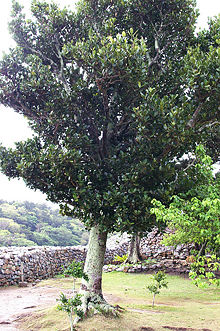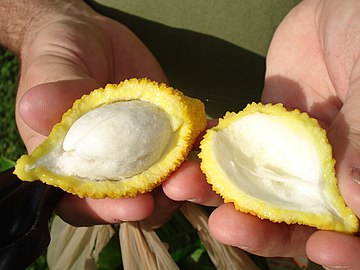Garcinia
| Garcinia | |
|---|---|

| |
| Garcinia subelliptica, the fukugi tree | |
| Scientific classification | |
| Kingdom: | Plantae |
| Clade: | Tracheophytes |
| Clade: | Angiosperms |
| Clade: | Eudicots |
| Clade: | Rosids |
| Order: | Malpighiales |
| Family: | Clusiaceae |
| Tribe: | Garcinieae
|
| Genus: | Garcinia L. |
| Species | |
| Synonyms | |
| |
Garcinia is a genus of
Many species are threatened by
The fruits are a food source for several animals, such as the archduke butterflies (Lexias spp.) of tropical eastern Asia which relish the sap of overripe mangosteens.
The genus is named after French botanist Laurent Garcin (1683–1751).[3]
Description
Garcinia species are
Uses

The fruit of most species of Garcinia are eaten locally; some species' fruits are highly esteemed in one region, but unknown just a few hundred kilometres away. The best-known species is
In addition, mangosteen rind (
Most species in Garcinia are known for their
Extracts of the exocarp of certain species – typically
Bitter kola (
freshening the breath and cleaning the teeth.-
endocarp
-
Garcinia gardneriana (bacupari)
Species

As of December 2018[update], Kew's Plants of the World Online lists nearly 400 accepted species.[1] Selected species include:
- Garcinia acutifolia
- Garcinia afzelii
- Garcinia aristata
- Garcinia assamica
- Malaysian)
- Garcinia benthamiana – asashi
- Garcinia bifasciculata
- Visayan)
- Garcinia brasiliensis– bacupari-mirim
- Garcinia brevipedicellata
- Garcinia burkillii
- Garcinia cadelliana
- Garcinia cantleyana
- Garcinia celebica L.
- Garcinia clusiaefolia
- Garcinia costata
- Garcinia cowa - cowa mangosteen
- Garcinia decussata
- Garcinia diversifolia
- Garcinia dulcis – mundu, rata
- Garcinia echinocarpa
- Garcinia epunctata
- Garcinia eugeniaefolia
- Garcinia forbesii - rose kandis
- Garcinia gardneriana – bacupari
- Garcinia gummi-gutta – gambooge, garcinia cambogia, brindleberry, brindall berry, Malabar tamarind
- Garcinia hanburyi – Hanbury's garcinia
- Garcinia hendersoniana
- Garcinia hermonii
- Garcinia holttumii
- Garcinia hombroniana - seashore mangosteen
- Garcinia humilis – achachairú, achacha
- Garcinia imberti
- Garcinia indica – wild mangosteen, kokum
- Garcinia intermedia – lemon drop mangosteen, machare
- Garcinia kingii
- Garcinia kola – bitter kola
- Garcinia lateriflora – Kandis (Palawan)
- Garcinia leptophylla
- Garcinia linii
- Garcinia livingstonei – African mangosteen, Lowveld mangosteen, Livingstone's garcinia, imbe
- Garcinia loureiroi - (Khmer: សណ្ដាន់)
- Garcinia macrophylla – pungara
- Garcinia madruno (Kunth) Hammel – charichuelo
- Garcinia magnifolia – bebasajo
- Garcinia maingayi
- Garcinia mangostana– purple mangosteen
- Garcinia microcarpa
- Garcinia minutiflora
- Garcinia monantha
- Garcinia montana
- Garcinia morella – ireevalsinni (Tamil)
- Vietnamese)
- Garcinia murtonii
- Garcinia nigrolineata Planch. ex T.Anderson
- Garcinia nitida
- Garcinia oliveri
- Garcinia opaca
- Garcinia parvifolia - Kundong, Brunei cherry, Asam aur aur
- Garcinia paucinervis
- Garcinia pedunculata
- Garcinia prainiana – button mangosteen, cherapu
- Garcinia pseudoguttifera - mo'onia tree
- Garcinia pushpangadaniana
- Garcinia pyrifera
- Garcinia quaesita
- Garcinia rubro-echinata
- Garcinia scortechinii
- Garcinia semseii
- Garcinia sessilis Seem. – heilala (Tongan), seilala (Samoan)
- Garcinia spicata - bitter garcinia
- Garcinia staudtii
- Garcinia subelliptica - fukugi tree
- Garcinia terpnophylla
- Garcinia thwaitesii
- Garcinia travancorica
- Garcinia uniflora
- Garcinia warrenii F.Muell.
- Garcinia wightii
- Garcinia xanthochymus – yellow mangosteen, gamboge
- Garcinia zeylanica
Genetic Diversity
The genetic diversity of 22 Garcinia accessions was analyzed using peroxidase, RAPD markers, and gene sequence-specific amplification polymorphism (GSSAP).[9] Genetic diversity assessment revealed low genetic variation among them.[9] Phylogenetic analysis indicated that Garcinia species clustered into five groups at a mean similarity coefficient of 0.54.[9] This study showed that the G. magostana accessions can be clearly distinguished by combined peroxidase, RAPD, and gene sequence-specific amplification polymorphism.[9]
References
- ^ a b "Garcinia L." Plants of the World Online. Royal Botanical Gardens Kew. Retrieved 21 December 2018.
- . Retrieved 12 January 2018.
- ^ "Garcinia forbesii". www.nparks.gov.sg. Retrieved 23 January 2021.
- .
- PMID 18436094.
- PMID 15680676.
- ^ 20 Super Health Benefits Of Eating Bitter Kola (Garcinia Kola)
- . Retrieved 12 January 2018.
- ^ a b c d Wittayawannakull, W. ; Garcia, R. N. ; Yllano, O. B. ; Borromeo, T. H. ; Namuco, L. O. ; Tecson-Mendoza, E. M. (2010). "Assessment of genetic diversity in Garcinia species using peroxidase, RAPD and gene sequence specific amplification polymorphism (GSSAP)". Philippine Agricultural Scientist. 93: 31–41.
{{cite journal}}: CS1 maint: multiple names: authors list (link)




